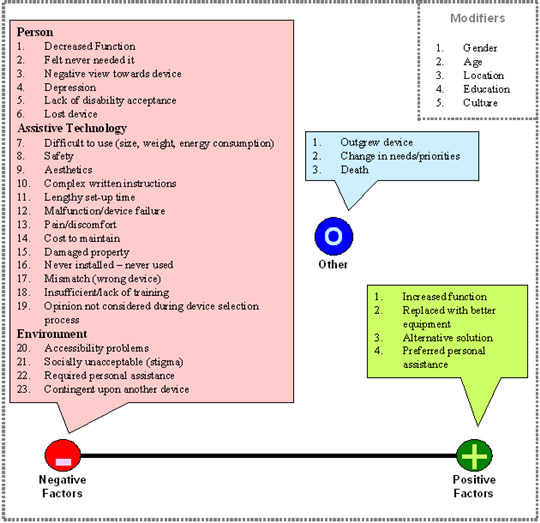Return to Figure 2 in the "Discontinuance" report
Figure 2: A Conceptual Model of Positive & Negative Discontinuance

Figure 2 is a diagram that primarily illustrates positive and negative device discontinuance. At the bottom of the figure is a continuous scale with two end anchor points, which are labeled negative factors (on the left) and positive factors (on the right). Each contains reasons for discontinuance. Above is another category labeled “Other,” which contains factors that could not be classified as positive or negative. Yet, they are not neutral, because depending on the individual who stopped using the device, the factor may seem positive or negative. Surrounding all three groups is a dotted line representing modifying variables, which consist of the following demographical information: 1) gender, 2) age, 3) location, 4) education, and 5) culture. Each modifying variable is unique to each person, which can influence the amount of impact all factors can have on an individual
The negative factors are comprised of 23 reasons that are organized into three areas 1) Person, 2) Assistive Technology and 3) Environment. Areas relating to the “person” contain the following six factors: 1) decreased function, 2) felt never needed it, 3) negative view towards device, 4) depression, 5) lack of disability acceptance and 6) lost device. The “Assistive Technology” category is composed of the following thirteen service and device aspects: 1) difficult to use (size, weight, energy consumption), 2) safety, 3) aesthetics, 4) complex written instructions, 5) lengthy set-up time, 6) malfunction/device failure, 7) pain/discomfort, 8) cost to maintain, 9) damaged property, 10) never installed – never used, 11) mismatch (wrong device), 12) insufficient/lack of training, and 13) opinion not considered during device selection process. Social and physical context have been grouped into one category known as “Environment,” which includes four factors: 1) accessibility problems, 2) socially unacceptable (stigma), 3) required personal assistance, and 4) contingent upon another device.
On the opposite side of the continuum are the positive factors which consist of five aspects: 1) increased function, 2) replaced with better equipment, 3) alternative solution and 4) preferred personal assistance. (A more detailed description is provided within the text of this thesis.)




